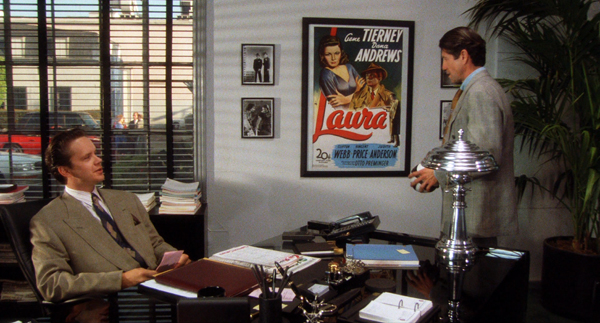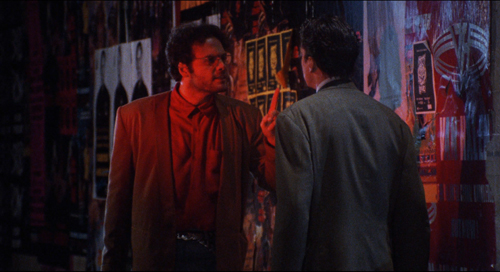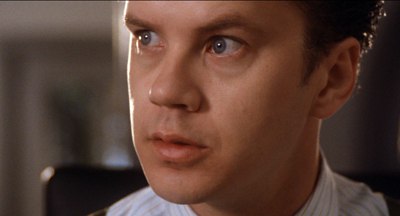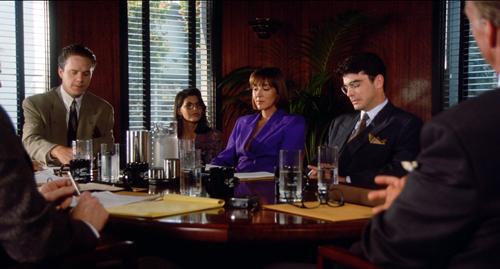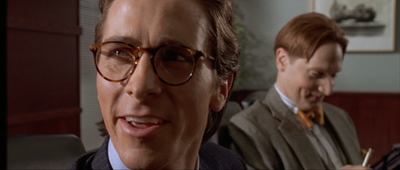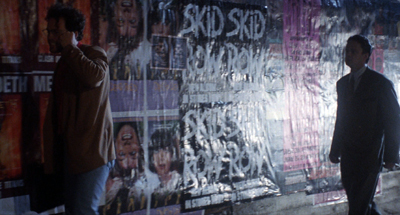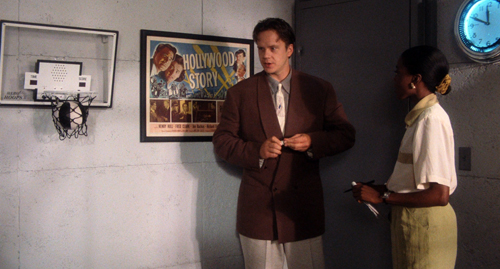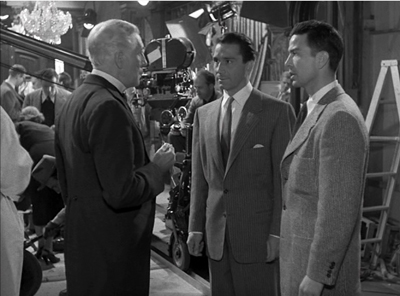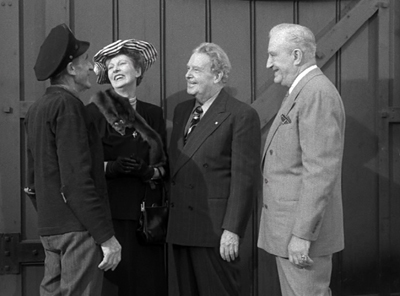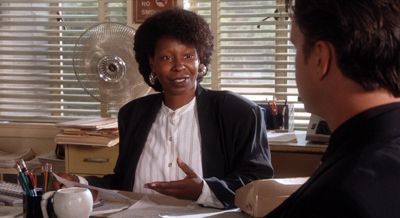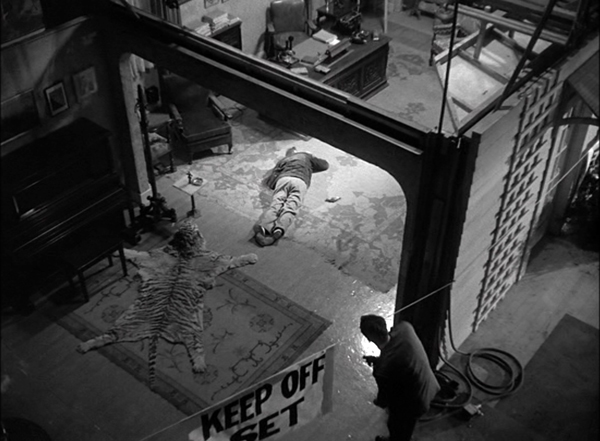Who got played? A guest post by Jeff Smith on THE PLAYER
Monday | February 5, 2018 open printable version
open printable version
The Player (1992).
Jeff Smith, our collaborator on Film Art: An Introduction just recorded an installment of our Observations on Film Art series for the Criterion Channel on FilmStruck. Here’s a supplement to that. –DB
In my installment, focusing on genre play in The Player, I discuss Robert Altman’s film in relation to two important traditions in Hollywood cinema: crime thrillers and films about filmmaking. As anyone who knows Altman’s other films would expect, The Player toys with the conventions of both genres in a number of different ways.
As I note in the video, The Player was received as something of a comeback film for Altman. It augured a resurgence in the director’s career that ultimately produced such late masterpieces as Short Cuts and Gosford Park.
Today, I sketch out some additional ideas about The Player’s use of genre conventions. I hope to shed light on some other connections to the crime thriller that I didn’t discuss in the video. I also hope to show just how unusual the film is in this context. Spoilers ahead, not only for The Player but for the novel and film of The Ax.
Will the real Griffin Mill please stand up?
In Reinventing Hollywood, David notes that there are usually four sorts of characters involved in a crime thriller plot: victims, lawbreakers, forces of justice, and more or less innocent bystanders. Filmmakers customarily organize the film’s narration around one or more of these character roles. Typically, a cascade of further choices flows from this initial decision about whose perspective forms the focal point of the story.
In The Player, much of the narration is restricted to the knowledge of the protagonist, Griffin Mill. The film includes a few scenes where Griffin is not present, like the one where the studio’s management awaits his arrival at a meeting. That, in itself, is not unusual. Many thrillers, like Chinatown or The Ghost Writer, employ similar tactics. What is slightly unusual is the fact Griffin takes on two of the typical character roles in the crime thriller as both victim and lawbreaker.
Griffin is a suit, and as a studio functionary he doesn’t immediately engender audience sympathy. Our first glimpse of Griffin shows him listening to pitch sessions. His questions to the people proposing new film projects are glib and capricious, representing the worst aspects of Hollywood commercialism.
Yet The Player does marshall some sympathy for Griffin as the victim of a stalker. Every time Griffin finds a postcard in his mail or on his car, it reminds us that he might be in mortal danger. After the stalker plants a venomous rattlesnake in Griffin’s passenger seat, we can’t believe the threats are empty.
Any sympathy that Griffin garners as a result of this psychological warfare is mollified, though, when the victim becomes victimizer. As Griffin later explains to June, his job is to tell people “no” more than a thousand times each year. Griffin believes that one of these rejections is the reason for the threatening postcards he receives. But he tragically miscalculates in targeting aspiring screenwriter David Kahane as the likely suspect.
Griffin contrives a meeting with Kahane at a Pasadena movie theater, and having bumped into him, tries to make amends. Yet Kahane recognizes that he is being pimped. This leads to a shouting match in a parking lot with Kahane threatening to ruin Griffin’s reputation. And when Kahane accidentally knocks Griffin over with his car door, Griffin reacts with rage, grabbing the screenwriter’s head and banging it repeatedly against the lot’s concrete surface. Although it seems clear that Griffin was acting on impulse, he’s nonetheless crossed a line that separates victims from perpetrators.
More importantly, Griffin’s violent action complicates the viewer’s allegiance to him. Altman establishes a dramatic context in which the motivations for Griffin’s crime seem completely understandable. Yet whatever sympathies viewers might have for Griffin are muddled by his creepy romantic interest in Kahane’s girlfriend; his cruel treatment of Bonnie, his current partner; and the general smarminess he exudes as a successful but shallow executive. Crime thrillers often ask audiences to sympathize with heels. There’s nothing that Griffin does that is inherently evil, but there’s nothing to really like. It’s less about his crime and more about his slime.
Griffin’s passage from victim to lawbreaker also alters the typical thriller plot. At the start of the film, Griffin himself functions as the investigative agent, trying desperately to figure out who is threatening him. Once Griffin becomes a suspect himself, though, that line of action halts, and the Pasadena police’s investigation of Kahane’s death springs up in its place.
This shift in the direction of the plot doesn’t really change the film’s pattern of narration. We remain as ignorant of the police’s activities as Griffin is. What does change are the stakes of the narrative. Instead of eliciting curiosity and suspense about Griffin’s stalker, we now wonder whether he’ll ever be brought to justice for Kahane’s death. Despite its strong connections and frequent allusions to crime fiction, The Player is not so much a whodunit as it is a will-he-get-away-with-it.
They smile in your face, all the time they want to take your place….
Besides blurring the boundaries between Griffin’s role as both victim and lawbreaker, The Player falls into a specific subgenre of crime fiction: the corporate thriller. Since, the corporate thriller is mostly defined by its setting, it blends pretty easily with the typical thriller plots and characters.
Like the spy thriller, the corporate thriller can focus on protagonists engaged in industrial espionage, as we see in Duplicity, Demon Lover, or Paycheck. Christopher Nolan’s Inception blends the plot mechanics of these corporate espionage thrillers with science fiction tropes to provide a narrative frame, but then embeds elements of the heist film within it.
Like the political thriller, the corporate thriller might also focus on the backroom deals and machinations that enable the protagonist to move up the company ladder. A film like Disclosure is a paradigm case. But even romantic comedies or prestige dramas can borrow elements from it. (Think Working Girl and Glengarry Glen Ross.)
More commonly, though, corporate thrillers feature elements drawn from the crime thriller. The roots of this approach to the genre stretch back a long way and can be found in both literary and cinematic antecedents. Some plots, for example, follow investigations that expose corporate malfeasance. Others focus on murders committed within a corporate environment, as in Dorothy Sayers’s novel Murder Must Advertise and Kenneth Fearing’s novel (and film) The Big Clock and in more modern instances like Michael Crichton’s Rising Sun and John Grisham’s The Firm. Other corporate crime thrillers, like Bret Easton Ellis’s American Psycho (below) and Cindy Sherman’s Office Killer, involve serial murders in white-collar environments.
The corporate crime thriller enables writers and filmmakers to explore thematic parallels between the acts of brutality and violence committed by individuals and the cutthroat tactics employed by business institutions. The plots of many gangster films center on rival mobs battling for competitive dominance in black market trades. Such conflicts often seem like a logical extension of the laissez-faire principles that undergird capitalism. Corporate crime thrillers tread similar thematic territory. They sometimes suggest that the personality traits that make for good business executives and titans of industry are the same ones that produce sociopaths and serial killers.
The Player presents the familiar corporate-thriller rivalry, as Griffin works behind the scenes to outmaneuver Larry Levy. For example, Griffin momentarily ponders using Larry’s admission that he attends Alcoholics Anonymous meetings as a way of embarrassing him within the company. Larry quickly undercuts this strategy, though, when he states that he just goes to the meetings because they are a great place to network.
Even more telling is Griffin’s efforts to saddle Larry with a loser project, Habeas Corpus. Midway through The Player, Griffin makes a deal with Andy Civella and Tom Oakley at a Los Angeles restaurant. The next day, he convinces his boss to greenlight the project with Larry as producer, knowing that Tom will likely prove difficult to work with and that his plan to use unknown actors has disaster written all over it. Larry, though, has the last laugh when we get a sneak peek of Habeas Corpus at film’s end. Not only does it have big stars in Julia Roberts and Bruce Willis. It also has the kind of happy ending that the pretentious Tom claimed was too Hollywood when he pitched the project. It turns out Tom cares more about the results of preview screenings than he does the purity of his artistic vision.
Not surprisingly, Altman doesn’t give us a wholly straightforward version of the corporate thriller. In a reflexive and ironic touch, Griffin’s successful ascent to studio boss seems to be secured by the same mysterious stalker who’d been taunting him at the start of the film. In a phone call, the stalker pitches Griffin the plot of the film we’ve just been watching, using his knowledge of Griffin’s crime to leverage his project into development. Here we see Altman slightly reframing the genre’s thesis about the relationship between crime and business. Griffin’s pact with his blackmailing stalker is simply a mildly illicit version of the sorts of quid pro quo arrangements upon which thousands of business deals are made.
If Griffin’s efforts to forestall a rival evoke the political thriller, then his killing of screenwriter David Kahane connects The Player to the corporate crime thriller. Once again, Altman deviates from some of the conventions. The crime doesn’t take place inside a corporate setting, as in Rising Sun and Murder Must Advertise. Griffin kills Kahane in the very public space of a Pasadena parking lot, with film noir overtones.
Similarly, Griffin’s victim is not a colleague, co-worker, subordinate, or client. Rather, Kahane is someone with whom Griffin has had minimal contact, a name plucked almost randomly from a directory of screenwriters in order to jog Griffin’s memory. Consequently, Griffin’s motives for confronting Kahane seem quite different from the culprits in other corporate crime thrillers. More often than not, the murderers in these other stories fear job loss or try to silence others in an effort to cover up some smaller crime or bungled action. Griffin’s actions with Kahane spring from fear about threats to his physical well-being, not from threats to his continued employment. (The latter is Larry’s role.)
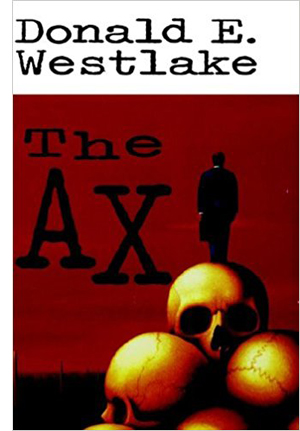 Some of The Player’s deviations from more conventional corporate crime thrillers come into relief if we compare it to Donald Westlake’s novel The Ax, a purer example of the genre. The Ax tells the story of Burke Devore, a production line manager recently downsized out of his job at a paper company. Still unemployed after eighteen months, Burke creates a phony job advertisement, and then begins to kill off the seven applicants he believes have the same qualifications he does. His plan is to eliminate all of the other unemployed middle managers in the paper business so that his resumé will land at the top of the pile when a new factory opens in his area.
Some of The Player’s deviations from more conventional corporate crime thrillers come into relief if we compare it to Donald Westlake’s novel The Ax, a purer example of the genre. The Ax tells the story of Burke Devore, a production line manager recently downsized out of his job at a paper company. Still unemployed after eighteen months, Burke creates a phony job advertisement, and then begins to kill off the seven applicants he believes have the same qualifications he does. His plan is to eliminate all of the other unemployed middle managers in the paper business so that his resumé will land at the top of the pile when a new factory opens in his area.
Like Altman, Westlake has some fun with his central conceit. Just as The Player includes faux film clips and rushes as a means of satirizing Hollywood production practices, The Ax incorporates fictional resumes that tweak jobseekers’ business-speak. What makes Westlake’s social criticism in The Ax so resonant, though, is the utter banality of Burke’s ambitions. He doesn’t aspire to the garish lifestyle we see displayed by Tony Montana or Jordan Belfort in Scarface and The Wolf of Wall Street respectively. Instead Burke just wants to return to his modest middle-class lifestyle and to the dignity that a decent job afforded him. Serial murder just seems like the simplest way to achieve that.
As this comparison suggests, one of the things that makes The Player somewhat unusual as a corporate crime thriller is its play with character motivation and point of view. Facing threats and intimidation, Griffin looks more like the target of a crime than a perpetrator. In corporate thrillers, the lawbreaker is more likely to be somewhere in the middle of the corporate ladder, like Burke, than at the top of it. Moreover, although his actions are motivated by a strange combination of both vanity and insecurity, Griffin more or less stumbles into the crime he commits rather than coolly plotting it the way Burke does.
Despite these differences, The Player and The Ax share an important feature that markedly deviates from the crime thriller as a whole. Both Griffin and Burke get away with it. The plots of most crime thrillers resolve in ways that balance the scales of justice. The bad guys are usually either arrested or killed after climactic confrontations with law enforcement. But this doesn’t always happen. Burke, Patrick Bateman in American Psycho, and Dorine in Office Killer escape punishment. Even though Jordan Belfort is arrested in The Wolf of Wall Street, he gets a slap on the wrist for his crimes.
Perhaps this aspect of the corporate crime thriller reflects the cynicism and amorality that pervades the genre. After all, if your belief is that most corporations get away with murder in a figurative sense, then it’s not hard to accept this idea when it occurs in fictional contexts in a literal sense.
Still, in the case of The Player, the Pasadena police’s failure to prove their case against Griffin Mill may reflect a meshing of both authorial and generic tendencies. When Griffin embraces June in the stylized happy ending of The Player, it quite deliberately parallels the tacked on happy ending of Habeas Corpus we’ve seen just moments earlier. The dialogue Griffin exchanges with June amplifies the similarity between these scenes. When June asks, “What took you so long?”, Griffin responds, “Traffic was a bitch.” These are the exact same lines exchanged by Julia Roberts and Bruce Willis in Habeas Corpus. By allowing Griffin to get away with it, The Player’s “up” ending sharpens Altman’s critique of Hollywood convention, and allows him to subvert the kinds of mainstream genre filmmaking he’s long detested.
Both allusive and elusive: Comparing The Player to Hollywood Story
One of the other topics I discuss in my video essay on The Player is the way the film pays homage to various aspects of Hollywood tradition. Much of this is bound up with its satire of commercial filmmaking. But it also strengthens the film’s relation to the crime thriller. Throughout The Player, Altman makes reference to Hollywood’s past in multiple ways. Celebrity cameos, film posters, and production stills populate the mise-en-scene. The characters also frequently mention older film titles in dialogue.
Perhaps the most interesting allusion in The Player involves a poster of Hollywood Story that hangs in Griffin’s office. The latter is a 1951 film noir directed by William Castle, who later became famous for his use of outrageous gimmicks in the production and promotion of horror films. For The Tingler, Castle supervised the installation of devices that would vibrate theater seats, anticipating today’s 4DX Theater Experience in places like Los Angeles, New York, Seattle, and Orlando.
Hollywood Story dramatizes the efforts of film producer Larry O’Brien to develop a project around the unsolved murder of silent film director Franklin Ferrara. O’Brien hires one of Ferrara’s old scenarists to write the script. He also develops a close relationship with Sally Rousseau, the daughter of one of Ferrara’s biggest stars. Once the project is announced, O’Brien finds himself the target of an assassin’s bullet. He surmises that his assailant is trying to prevent the case from being reopened. And as Sally reminds O’Brien, he doesn’t have an ending to his movie is he can’t determine the killer’s identity. O’Brien, thus, sets out to solve the crime, bringing closure to one of the biggest scandals in Hollywood’s history. Hollywood Story offers an even better synthesis of The Player’s mixture of industry exposé and crime film story beats. O’Brien’s lone wolf investigation is treated as being a necessary stage of project development.
If the Franklin Ferrara story sounds vaguely familiar to you, well….it should. Hollywood Story offers a fictionalized account of the unsolved murder of William Desmond Taylor, who was shot to death in his bungalow in the wee hours of a February night in 1922. (David blogged about the crime here.) The subsequent investigation of Taylor’s death ensnared some of the industry’s biggest stars of the period. Mabel Normand’s reputation was tainted by her association with Taylor and by reports of drug use. She took a brief hiatus from filmmaking because of the scandal, but never completely recovered from it. Normand later died of tuberculosis in 1930 at the tender age of 37.
As a fictionalized account of a notorious unsolved crime, Hollywood Story anticipates more modern thrillers that provide speculative solutions to real-life murders. Zodiac and The Black Dahlia are prime examples, as are any number of Jack the Ripper films. Hollywood Story’s approach was not unprecedented. James M. Cain based Double Indemnity on the Ruth Snyder case that was fodder for New York tabloids in the late 1920s. That said, Taylor’s death lingered for decades in popular memory in a way that the Snyder case did not.
What are we to make of The Player’s citation of Hollywood Story? On the one hand, viewers might well notice the almost immediate parallel of our “film execs in jeopardy” storylines. Just as Griffin is stalked by an unknown assailant, so, too, is Larry the target of a shadowy aggressor. Moreover, Hollywood Story, along with Sunset Boulevard, might well be an inspiration of one of The Player’s most interesting features: its intermingling of real life stars with fictional characters. Hollywood Story includes cameos by Joel McCrea and several noted performers of the silent era, such as William Farnum, Francis X. Bushman, and Betty Blythe (below). The Player pushes this aspect of Hollywood Story to extremes, containing plentiful cameos by Cher, Jack Lemmon, Burt Reynolds, Lily Tomlin, Susan Sarandon, and other A-listers.
In several other respects, though, The Player seems like an inversion of Hollywood Story with Griffin emerging as a more venal counterpart to the latter’s crusading producer, Larry. In Hollywood Story, Larry’s investigation actually produces results. This strongly contrasts with Griffin’s guesswork, which, as the result of a tragic mistake, leads to David Kahane’s death in a Pasadena parking lot. In Hollywood Story, Larry’s blossoming romance with Sally furnishes the standard double plotline commonly found in classical cinema. In The Player, though, Griffin’s interest in June seems genuinely sleazy. It also exacerbates the Pasadena police’s doubts about Griffin’s alibi, making him their prime suspect. Finally, the revelation of screenwriter Vincent St. Clair as Franklin Ferrara’s killer provides closure both to Larry’s script and to Hollywood Story itself. In contrast, none of the crimes presented in The Player are really solved. Griffin is blackmailed into greenlighting a project during the film’s epilogue, but the audience never learns the identity of the mysterious stalker. Similarly, although the Pasadena police believe that Griffin is guilty of murder, the botched lineup ensures that he will go free and that David Kahane’s death will remain an unsolved crime. In an odd way, The Player returns to the narrative roots of Hollywood Story. The fate of Kahane, our aspiring screenwriter, seems destined to mirror that of poor William Desmond Taylor, our successful silent film director.
A thriller with no thrills
I’ve sketched out a number of different ways in which The Player relates to the basic conventions of the crime thriller, but all of this is ultimately, in the parlance of the genre, a red herring. This is because The Player is that rare bird: a crime film that engenders relatively little curiosity about its solution and even less suspense about the fate of its protagonist.
This is largely because Robert Altman mostly uses crime film conventions as scaffolding for the things that really interest him: quirky characters, digressive dialogue, and a loose, improvisatory feel to the film’s performances. At its heart, The Player is a comedy that draws upon crime film conventions in much the way Altman’s adaptation of Raymond Chandler’s The Long Goodbye does.
Compare, for example, each film’s tweaking of the genre’s standard interrogation scenes. In The Long Goodbye, Detective Farmer’s tough questioning of Philip Marlowe is punctured by the latter’s goofy responses. At one point, Marlowe uses the ink from his fingerprinting procedure like it was the “eye black” used by an athlete. Later, he smears the ink all over his face and sings “Swanee” in a mocking homage to Al Jolson in blackface. Similarly, in The Player, the Pasadena police’s interrogation of Griffin is disrupted by Detective Avery’s disarming exchange with her partner about tampons, her mangled pronunciation of “Gudmundstottir,” and her dialogue with Paul about Todd Browning’s Freaks.
The Player has many ingredients characteristic of crime films: a dead body, an investigation, a shady suspect, and a campaign of stalking and extortion. Yet, by the time Altman’s film reaches its ironic and deeply reflexive conclusion, viewers might well conclude that they are the ones who just got played.
Thanks as usual to Peter Becker, Kim Hendrickson, Grant Delin, and all their Criterion colleagues. A list of our Observations on Film Art series is here.
For more on Robert Altman’s career, see Patrick McGilligan’s excellent biography, Robert Altman: Jumping Off the Cliff. There are also several books featuring interviews with the iconoclastic director. These include David Sterritt’s Robert Altman: Interviews, Mitchell Zuckoff’s Robert Altman: The Oral Biography, and David Thompson’s Altman on Altman.
Those interested in learning more about crime fiction should consult Martin Rubin’s Thrillers, Charles Derry’s The Suspense Thriller: Films in the Shadow of Alfred Hitchcock, John Scaggs’s Crime Fiction, Richard Bradford’s Crime Fiction: A Very Short Introduction, and Martin Priestman’s The Cambridge Companion to Crime Fiction.
Hollywood Story (1951).












